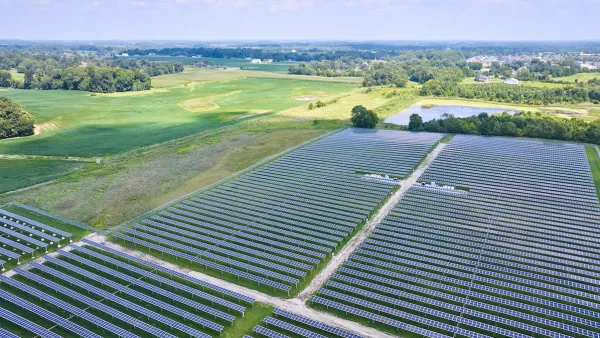The green marketplace is the marketplace of the future. From Wal-Mart to Toyota to the neighborhood dry cleaner, it seems like every business is going out of its way to tell us how green they are. That could either be a great thing because these businesses are actually using environmentally-friendly practices, or it could be a bad thing because they're just claiming to be green. Regardless of whether it's one or the other, what's certain is that they say they're green because that's what we want to hear.
The green marketplace is the marketplace of the future. From Wal-Mart to Toyota to the neighborhood dry cleaner, it seems like every business is going out of its way to tell us how green they are. That could either be a great thing because these businesses are actually using environmentally-friendly practices, or it could be a bad thing because they're just claiming to be green. Regardless of whether it's one or the other, what's certain is that they say they're green because that's what we want to hear.
This market's existence and growth was hammered home by the recent VerdeXchange Green Marketmakers Conference in Los Angeles. The conference pulled together an impressive list of green-thinking politicians, public officials, private business people and practitioners from around the globe to discuss trends in the environmentally-conscious market and to outline how businesses and communities can actually be as green as they love to say they are.
As it goes with these types of events, there were a lot of people talking about all the great things they're doing, all they great things they're going to be doing, and all the great things they could be doing if the government worked better. Beyond the spin and the sell, a few major themes stuck out to me (based on a select few of the day's many sessions).
Renewable Energy Transmission
It seems like every single person in attendance talked at some point about renewable energy. It's an appropriate subject, and one that seems to dominate the general perception of what it means to be green. An aspect I hadn't really given much thought to previously is transmission. Getting all that renewable power from the plant out into the grid is a pretty crucial element of the whole scheme, and one that has been a major hurdle, possibly even moreso than development of the renewable energy technology itself.
Cities love to tout how much alternative and renewable energy they use, but that amount is severely limited by how easily that power can get to the city. Many within the renewable industry have bemoaned the federal and state permitting process, which they say draws the process out to sometimes excruciating timeframes. They're calling for an update to the permitting process that can get projects moving – and generating energy – faster. But with thousands of miles of transmission lines, the footprint can have a major impact on communities and habitats. Siting power plants and transmission lines seems to be one of the major challenges ahead for the renewables industry.
California's Environmental Leadership
The state has been at the forefront of many environmental movements, and recent legislation within California has offered guidance for the rest of the country. It's notable that on the day of this conference, President Barack Obama reversed a controversial Bush administration decision, and ordered the Environmental Protection Agency to reconsider a state plan to set higher emissions standards for automobiles. That law, AB1493, has garnered the support of 12 other states and is widely seen as a major step in expanding the government's influence over fuel efficiency in the U.S.
Another of California's laws that received plenty of lip service was AB32, The Global Warming Solutions Act of 2006, which requires the state to bring greenhouse gas emissions down to 1990 levels by 2020. It's no Kyoto, but many green thinkers are calling it a good step for the country's most populous state.
And the third California crowd-pleaser is the "anti-sprawl" legislation SB375, which requires metropolitan planning organizations to include provisions in planning documents that aim at reducing greenhouse gas emissions. The 2008 law basically ties land use decisions to the greenhouse gas emissions they inevitably cause. The end result is, ideally, communities throughout the state that are built to limit the damage their physical form creates.
Water
Water is life, and here in America we are wasting our life. Twisted agricultural subsidies, desert-based explosive development, and the love of the lawn have pushed our needs beyond our means. As many speakers discussed, people and communities are going to have to, firstly, change their lifestyles and, secondly, get way more creative in reusing our most important resource. Much of the focus here was on reusing – like the wastewater reuse projects that have finally surpassed the yuck factor to become viable methods of recharging groundwater supplies. There are both technical opportunities for the green market people to explore and conservation methods cities and regions should consider. Combining the two – creative technologies and creative ideas – will help to spread the idea that protecting water sources means much more than turning off the tap while you brush your teeth.
What was great to see in the attendants of this conference was a broad range of industries and professions. There was also a huge Japanese presence, highlighting the nation's advancements in green technologies. But no matter where they came from the people at this conference were highly passionate and interested. Above all, they were primarily business people. This is not the environmentalist movement of the '70s – or even the '90s, for that matter. These are savvy people who not only see business opportunities, but intrinsically link environmental stewardship with their own success. The hippies grew up and they're showing that the environmental movement is about more than just green in the pipe. It's also about green in the wallet.

Analysis: Cybertruck Fatality Rate Far Exceeds That of Ford Pinto
The Tesla Cybertruck was recalled seven times last year.

National Parks Layoffs Will Cause Communities to Lose Billions
Thousands of essential park workers were laid off this week, just before the busy spring break season.

Retro-silient?: America’s First “Eco-burb,” The Woodlands Turns 50
A master-planned community north of Houston offers lessons on green infrastructure and resilient design, but falls short of its founder’s lofty affordability and walkability goals.

Test News Post 1
This is a summary

Analysis: Cybertruck Fatality Rate Far Exceeds That of Ford Pinto
The Tesla Cybertruck was recalled seven times last year.

Test News Headline 46
Test for the image on the front page.
Urban Design for Planners 1: Software Tools
This six-course series explores essential urban design concepts using open source software and equips planners with the tools they need to participate fully in the urban design process.
Planning for Universal Design
Learn the tools for implementing Universal Design in planning regulations.
EMC Planning Group, Inc.
Planetizen
Planetizen
Mpact (formerly Rail~Volution)
Great Falls Development Authority, Inc.
HUDs Office of Policy Development and Research
NYU Wagner Graduate School of Public Service



























